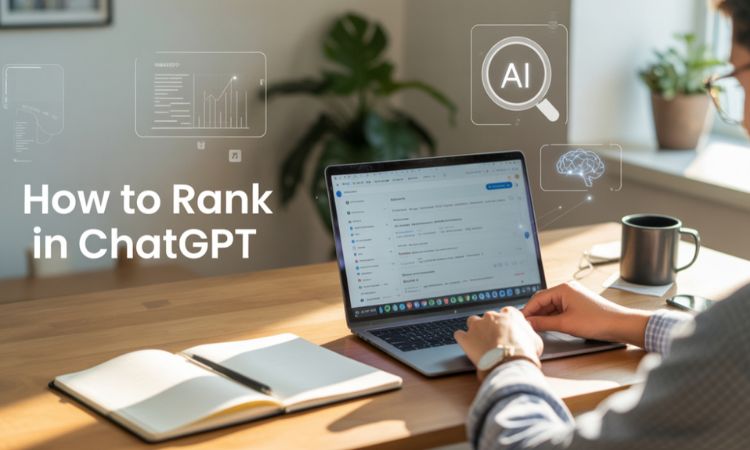There are two primary ways to increase your eCommerce website’s visibility on search engine result pages (SERPs): Search Engine Optimization (SEO) and Pay-Per-Click advertisements, also known as paid ads. In this blog, we will discuss SEO strategies for an eCommerce website to make your eCommerce website visible on the search engine result pages.
Table of Contents
ToggleWhat is eCommerce SEO?
SEO for eCommerce website is the process of optimizing your online store so it ranks higher in organic search results. In other words, it’s the process of improving your store’s visibility on Google, Bing, etc., so shoppers find you without clicking on paid ads.
For example, the paid ad appears above the organic results in this SERP mockup, and effective eCommerce SEO aims to get your site into that valuable organic section. By improving SEO for an eCommerce website, you drive more qualified traffic and sales without paying per click. In fact, as per the Semrush study, higher organic rankings help you attract more organic traffic, reach potential shoppers, build trust, and gain a competitive edge.
Searchers rarely go beyond page one of Google, so if your site isn’t ranking high, you’re missing out on traffic, leads, and conversions. In short, good SEO means your products and store show up when customers search, which is crucial for eCommerce success.
10 SEO Strategies for eCommerce Websites
Strategy #1: Conduct In-Depth Keyword Research
Effective keyword research is more than finding phrases – it’s choosing the right ones based on data and using them strategically. Here’s how to enhance the process:
1. Use Data to Pick Keywords
- Monthly Search Volume & Difficulty: In tools like Google Keyword Planner, Ubersuggest, or Semrush, check each keyword’s average monthly searches and its difficulty or competition score. Aim for terms with decent volume but moderate or low difficulty, especially if your site is new or smaller. For example, “affordable saree online India” might have higher volume but also higher competition; a related long-tail like “handloom cotton saree Jaipur online” could balance volume and ease of ranking.
- Trends & Seasonality: Look at search trends over time. Keywords tied to festivals or seasons (e.g., “Diwali gift hampers”) may spike at certain times. Update your research regularly (quarterly or before major sale seasons) so you capture new patterns or emerging products.

2. Group and Prioritise by Intent & Potential
- Informational vs. Transactional: Label keywords based on whether users are researching (“how to style red dress”) or ready to buy (“ buy red dress for women”). Prioritise transactional terms for product pages and consider informational ones for blog posts or guides that feed into your sales funnel.
- Local & Long-Tail Focus: In India, adding location or niche qualifiers helps. For instance, “online kurta shop Ahmedabad” or “best monsoon raincoat for men India” often have lower competition and clearer purchase intent. Group these separately so you can assign them appropriately (e.g., local landing pages or region-specific promotions).

Apply the ‘Intent’ filter to view only informational and transactional keywords. Don’t forget to hit ‘Apply’ to activate the filter.”
3. Decide Where to Use Each Keyword
- Product Pages: Use high-intent transactional keywords in product titles, URLs, meta titles, and meta descriptions (e.g., “Buy Bluetooth Earbuds with Noise Cancellation”). Also place related terms in headings (H1/H2), bullet lists of features, and image alt text.
- Category Pages: Target broader, mid-intent keywords here (e.g., “Women’s Ethnic Wear Online”) in the page title, introductory paragraphs, and H2s. A brief descriptive intro helps search engines understand the page focus.
- Blog & Informational Content: Place informational or long-tail keywords in blog post titles, subheadings, and within the content (for example, a post on “How to care for silk sarees after Diwali”). Use these posts to link naturally to relevant product or category pages.
- Site-Wide Elements: Include your top brand or flagship product keywords in homepage title tags or site-wide banners sparingly, without keyword stuffing.
4. Regularly Refresh Your Research
- Monitor Performance: Use Google Search Console or SEO tools to see which keywords bring traffic and which pages rank. If a keyword’s performance drops or a new related term emerges, update the content or target pages accordingly.
- Adapt to Market Changes: New trends, products, or competitor moves can change search behaviour. Schedule periodic reviews (e.g., before festive seasons or quarterly) to add fresh keywords, remove obsolete ones, and adjust priorities.
Strategy #2: Optimize Product Pages (On-Page SEO)
Product pages are the heart of your store’s SEO. Each product page should be fully optimized:
Titles and URLs: Use descriptive, concise product names in both the page title and URL slug. Include key attributes (e.g. https://yourstore.com/kurtas/red-embroidered-kurta-women).
Meta title & description: Craft unique, keyword-rich title tags (30–60 chars) and meta descriptions (70–155 chars) for each product. Start titles with the product name/keyword, and include your brand/store name at the end. Good meta descriptions highlight benefits (e.g., “Free shipping, same-day delivery!”) to improve click-through.

Headings: Use the product name as the H1. Break up content with H2s for features, specifications, reviews, and FAQs. For example:
- H1: Handcrafted Cotton Kurta – Red Floral Pattern
- H2s: Features, Technical Specifications, Customer Reviews, Q&A.
Product Descriptions: Write unique, engaging descriptions that clearly state the benefits and specs. Don’t copy the vendor’s generic description. Highlight what makes your product stand out (e.g., fabric type, craft details, size info) and use relevant keywords naturally. List important specs (dimensions, ingredients, etc.) so searchers find exactly what they need.
Product Attributes & Linking: Mention and link product attributes (brand, series, color, gender, size) to the relevant category pages. For example, link “cotton” to a “Cotton Fabrics” page or a “women’s clothing” page to strengthen internal links.
High-Quality Images: Include clear, high-res product photos (e.g., front, side, detail shots) and optimize them. Name image files descriptively (e.g., red-floral-kurta.jpg), add keyword-rich alt text (“Red embroidered kurta for women”), and compress images to balance quality and speed. Also use the modern WebP format if possible for faster loading. Finally, include images in an image sitemap so Google can index them.
Product Schema Markup: Add JSON‑LD Product schema (including name, image, description, offers, availability, ratings) so search engines can show rich results (price, stock, reviews) and AI tools can more easily identify and surface your product details.
These on-page SEO optimization hacks will help you improve your SEO for eCommerce website.
Strategy #3: Improve Site Architecture & Internal Linking
A clear site structure helps users and search engines navigate your store. Aim for a flat architecture where any page is no more than 2–3 clicks from the homepage. In practice, group products into a logical hierarchy (e.g. Home > Clothing > Women’s Kurtas > Cotton Kurtas). Key tactics:
- 3-Click Rule: Structure menus and categories so that no product is buried deep. The “Golden Rule” is that the final page (product) should be reachable within three clicks from the home page. This preserves page authority and makes it easier for both users and Google to find products.
- Breadcrumb Navigation: Implement breadcrumb trails on product and category pages (e.g. Home > Electronics > Mobiles > Smartphones). This not only aids user navigation, but also distributes link equity through the site. Be sure to mark up breadcrumbs with Schema markup so Google understands your site’s hierarchy.
- Cross-Link Related Items: Within your content, link between products and categories where relevant. For example, from a specific red kurta page, link to the All Kurta category, the Red Dresses category, or related products (matching accessories). Also add a “Related products” or “Customers also bought” section on product pages – this keeps shoppers engaged and strengthens internal linking.
- XML Sitemaps: Use XML sitemaps to help search engines discover your content. Submit separate sitemaps for your category pages, product pages, blog posts, etc. Make sure all indexable product pages (HTTP 200) are listed so Google can crawl them efficiently.
Strategy #4: Focus on Technical SEO
While great content and strong backlinks are essential for SEO, none of it matters if your website’s technical foundation is weak. Technical SEO ensures that your site is fast, secure, mobile-friendly, and easily crawlable by search engines. It’s about optimizing the behind-the-scenes elements that directly impact your site’s user experience and search rankings. Without proper technical SEO, even the best content can go unnoticed by Google.
Here are the key technical SEO elements you should focus on:
- Speed & Performance: Use a CDN, compress and minify images/CSS/JS, lazy-load below-the-fold assets, and monitor Core Web Vitals (LCP, FID, CLS). Even a 100 ms delay can cost 1 % in sales.
- Mobile-First Indexing: Ensure a responsive design and fast mobile load times—Google now ranks the mobile version of your site first.
- HTTPS Everywhere: Migrate to SSL so all pages (especially checkout) run on HTTPS—browsers and Google both favour secure sites.
- Crawl Health & Sitemap: Regularly check Google Search Console for errors, use canonical tags to avoid duplicate-content issues, and keep your XML sitemap and robots.txt updated so crawlers focus on your key pages.
- Crawl Budget Management: Remove low-value pages (like filters, duplicates, internal search results) and block unnecessary ones in robots.txt. This helps Google spend its crawl budget on your most important product and category pages.
Strategy #5: Create Valuable Blog Content
A blog lets you target additional keywords and provide value beyond product pages. For example, Semrush advises attaching a blog to your store and writing articles that target search terms relevant to your products.
Find Blog-Specific Keywords: Use tools like Google Keyword Planner, Answer the Public, or AlsoAsked to find informational queries your audience is searching (e.g. “how to style a kurta” or “best fabrics for summer”).
Cluster Keywords into Topics: Group similar queries into content clusters. For example, combine “how to wash silk sarees,” “how to store silk clothes,” and “how to remove stains from silk” under one broader blog post or interlinked series.
Answer Customer Questions: Write posts that solve shoppers’ problems or interests (how-tos, gift guides, trends). In an Indian context, topics like “Choosing the right monsoon gear” or “Top Diwali deals on electronics” can attract relevant traffic.
Include Products Naturally: Feature your products within the content (with internal links). A blog post becomes a “soft sell” that guides a reader to your product pages.
Evergreen & Seasonal Content: Mix evergreen topics (e.g. “How to wash silk sarees”) with timely content (festival sale announcements, festival gift guides).
SEO and Link Opportunities: Quality articles tend to attract natural backlinks over time. If your blog becomes a useful resource, other sites (influencers, news, hobby sites) may link to it. Also, share your content on social media and newsletters to amplify reach.
Strategy #6: Optimize Category Pages
Category pages (e.g. “Men’s Shoes” or “Mobile Phones”) often capture higher-level, high-volume keywords. Yet they are often thin on content. Optimize them like mini landing pages:
Unique Titles and H1: Use the category name plus a modifier if needed (e.g. “Women’s Kurta – Shop Trendy Ethnic Wear”). Include main keywords in the title tag and H1 heading.
Introductory Content: Add a short paragraph (50–100 words) at the top describing the category. For example, on a “Smartphones” category page you might note popular brands, new arrivals, or key features. Google’s John Mueller has stated that category pages without any textual content (other than product links) are “really hard to rank”. A sentence or two of relevant text helps Google understand the page’s focus.
FAQ or Snippets: Consider adding an FAQ at the bottom of the page answering common questions about that product type. This adds more keyword-rich content for SEO and helps users.
Smart Use of Product Blocks: Show product listings prominently (to drive sales) but sprinkle some content in between or at the end. Keep content concise and above the fold when possible. Too much hidden content can confuse Google’s algorithms. Find a balance by providing valuable info without burying products.
Internal Links and Schema: If you have sub-categories (e.g. Mobiles > Android Phones), link to them clearly. Use Category schema where appropriate.
Strategy #7: Leverage User-Generated Content (UGC)
User-generated content like reviews, ratings, and customer photos is powerful for eCommerce SEO and conversion. UGC provides fresh, keyword-rich content and social proof. To leverage it:
- Enable Product Reviews & Ratings: Allow customers to leave reviews and ratings. Each new review adds unique content (often using buyer keywords) and signals quality to both users and Google. Apply Review schema so star ratings can appear in your search snippet (Conductor shows that product & review schema can yield enhanced snippets).
- Add Q&A Sections: Let customers ask and answer questions on product pages (e.g. “Does this shirt shrink after wash?”). This not only helps future buyers but also adds more content that Google can index. Mark up FAQs with FAQPage schema to potentially gain FAQ rich results.
- Show Customer Photos/Videos: Encourage shoppers to upload photos of them using the product, or use a branded hashtag on Instagram. Displaying these images adds visual content and authenticity. For example, beauty brand Glossier encourages users to post photos of themselves using its products, creating a community feel and fresh content.
- Social Proof: Feature testimonials or user stories on product/category pages. Even snippets (“5 stars – loved it!”) make your page more engaging.
Strategy #8: Build High-Quality Backlinks
Off-page SEO (link building) remains crucial for rankings. Links are votes of confidence from other sites. Focus on earning relevant, authoritative backlinks:
- Content-Driven Links: Create in-depth guides and tutorials (e.g., “Best Backpacks for Hiking in India”) that naturally attract links from related blogs and media.
- PR & Partnerships: Pitch stories, infographics, or data studies to bloggers, magazines, and complementary brands to earn featured links.
- HARO Contributions: Respond to journalist queries on Help a Reporter Out to get authoritative media mentions.
- Broken-Link Replacements: Find broken links on niche sites and offer your relevant pages as replacements.
- Local & Niche Directories: List your store on reputable directories—Justdial, IndiaMART, trade associations—to gain trusted citations.
- Influencer Features: Encourage influencers and social accounts to showcase your products; their posts often turn into backlinks over time.
Strategy #9: Optimize for Mobile-First Indexing
With most Indian shoppers browsing on smartphones, mobile optimization is non-negotiable. Google now indexes sites mobile-first, so your store must shine on small screens:
Responsive Design: Use a responsive website template that automatically adjusts layout for mobile screens. Keep content and navigation consistent with desktop. Avoid showing less content on mobile, since Google will use the mobile text for rankings.
Mobile Speed: Mobile page speed is especially critical (earlier stats show mobile users bounce more on slow pages). Optimize images (as above), use accelerated mobile pages (AMP) if feasible, and minimize blocking scripts.
Easy Navigation: Make menus thumb-friendly. For example, Sephora’s mobile site uses a simple, intuitive menu that mirrors its desktop mega-menu, ensuring mobile shoppers easily find categories. (See image below.)
Figure: Sephora’s mobile-friendly menu combines a familiar desktop-style mega-menu with an easy mobile layout.
User Experience: Avoid pop-ups that cover content on mobile. Ensure buttons are large enough to tap and text is legible. Use Google’s Mobile-Friendly Test to catch any issues.
Testing: Check Core Web Vitals on mobile via Google Search Console. For example, a retailer redesigning for mobile gave mobile users a “stellar experience” by prioritizing touch-friendly design.
Strategy #10: Track SEO Performance & Iterate
Use Google Analytics to track organic traffic, bounce rates, and conversions (sales/ sign-ups from search visitors). Use Google Search Console to monitor search queries, click-through rates (CTR), and any crawl/index issues. Look at which pages and keywords are performing well or poorly.
Track your important keywords to see if rankings improve. A small business might track terms like their brand name or top products. There are many tools (Semrush, Ahrefs, Ubersuggest) that let you track keyword positions over time.
Ultimately, focus on revenue. Are SEO visitors buying or converting? If not, maybe content or UX needs tweaking. You might need to optimize your product pages further or test new calls-to-action.
Periodically refresh old content and listings. For example, update blog posts with new information, add fresh images to products, or update category descriptions seasonally. Regularly adding or updating content can boost rankings.
Keep an eye on competitors’ SEO. If they start ranking for a keyword you want, analyze what they’re doing differently (content length, backlinks) and adapt.
Common SEO Mistakes to Avoid on eCommerce Sites
- Duplicate Descriptions: Reusing the same text across variants leads to duplicate content and keyword cannibalisation. Write unique, feature-focused descriptions for each item.
- Unoptimized Images: Missing alt text, vague filenames, or large files slow your site and waste ranking chances. Always name, tag, and compress product images.
- No HTTPS: Running on HTTP hurts trust and SEO. Secure every page – especially checkout – with SSL.
- Poor Handling of Out-of-Stock Items: Removing empty pages loses link juice. Instead, mark products “Out of Stock,” suggest alternatives, or 301-redirect to similar items.
Avoiding these pitfalls keeps your SEO for eCommerce on track and ensures you don’t lose hard-won traffic.
Conclusion
Effective SEO for an eCommerce website requires a holistic approach, from in-depth keyword research and on-page optimization to technical excellence and ongoing content/link-building efforts.
By applying the strategies above and avoiding common mistakes like duplicate content or broken security, small and large stores alike can improve their search visibility and sales.
Remember, SEO is not a one-time fix but a continuous process. Track your performance, learn from analytics, and adapt to changes in algorithms and customer behavior.
Following this SEO checklist will put your online store on the right path to higher rankings, increased traffic, and more customers.






